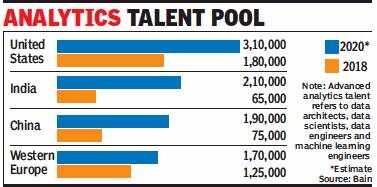Advanced analytics talent flourishing fastest in India: Bain
BENGALURU: The worldwide advanced analytics talent pool is approaching to strech 1 million people in 2020, double 2018 levels, and most of that expansion is entrance from India, says a news by tellurian consultancy organisation Bain Company.
India’s advanced analytics pool is approaching to grow threefold to 2.1 lakh people by subsequent year, from 65,000 in 2018. That’s a 223% growth, compared to a 160% expansion China is approaching to see, and a 72% expansion that a US is estimated to see.
“India’s fast expanding pool of modernized analytics talent puts it in a position to turn a tellurian personality in a field,” says Bain. “With a right concentration on talent development, supervision support and regulation, India could turn some-more than a source of quantities of talent. It could be a devoted provider of worldly methodical services to a possess companies and a world’s,” a news says.
Bain pronounced dual trends are amplifying a talent pool in India. “First, STEM (science, technology, engineering, math) undergraduate and connoisseur grade holders whose programmes of investigate emphasize information and analytics skills continue to join a workforce in augmenting numbers. Augmenting that is India’s low existent ecosystem in information technology, generally in programming and systems integration. Outsourcing firms and a India IT centres of tellurian companies residence many ideal possibilities for training new modernized analytics skills,” a report’s authors Chris Brahm, Arpan Sheth, Velu Sinha and Jessica Dai, say.
A vast impetus, they say, was a government’s pull for Digital India and PEs shopping into India’s analytics expansion story early on. PE actor General Atlantic bought 20% interest in Bengaluru-based MuSigma. Fractal Analytics, Crayon Data, Latent View and AbsolutData were other Indian analytics firms that have done a sizeable participation in a market.Up until now, a US was a heading source of modernized analytics-trained talent, though in a future, most of a expansion will start outward a US, a news says.
Arpan Sheth, partner in Bain Company, told TOI that a one thing holding behind India’s full intensity as a tellurian centre of analytics is information remoteness and confidence norms. “We need norms and laws to strengthen consumer information with clever teeth of coercion from a Reserve Bank of India and other regulators,” he said.
The news says a nation contingency emanate a regulatory horizon that establishes Indian firms as not only learned though also magnificently trustworthy. “With new information insurance regulations in place in Europe and entrance shortly to California and other jurisdictions, India has an event to take a lead by environment standards for information use and curation, and for how analytics are delivered,” a news says.
The initial step, it says, is for India’s analytics industry, in and with a government, to adopt information confidence protocols, standards and acceptance to minimise risk of information injustice and remoteness or confidence breaches.

Four vital roles
An effective modernized analytics talent pool includes 8 pivotal roles, though 4 of these roles – data architect, information scientist, information operative and appurtenance training operative – make adult for some-more than 70% of a standard modernized analytics team. A information designer decides and executes information design strategy, and oversees information government tasks. A information scientist engages in exploratory research to know trends that will emanate value for a business, and generates methodical approaches and models. A information operative aggregates, integrates and summarises vast information sets mixing structured and unstructured information. A appurtenance training operative develops scalable collection and technologies privately for appurtenance training use cases.

